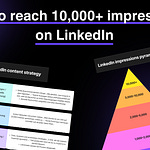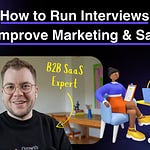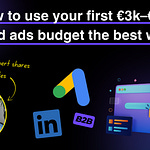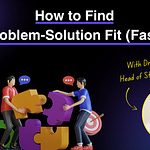For this episode I spoke with Thomas Kemp - an expert for B2B SaaS website messaging & positioning - to unpack the 5 most common mistakes he sees across B2B startups and give tipps on how to avoid them.
He’s worked on over 300+ B2B websites with his Clarity Sprints, helping Startups nail their website messaging and positioning.
This is what he shared:
New here? Each week, I share practical marketing strategies, tactics and learnings designed to help you scale your B2B business to €1 million ARR and beyond 🚀
Make sure to subscribe to not miss out on any episode!
1. Too Much Strategy, Not Enough Execution
Some startups think they’ve nailed their positioning. ICP, USP, competitive edge - check.
But then you land on their website… and none of it shows up.
Why it happens:
Strategy lives in Miro, Notion, or slide decks — but it never makes it into the actual messaging.
Why it’s a problem:
Your visitors don’t care what your internal docs say. They care what your homepage tells them in the first 5 seconds.
How to fix it:
Check your website. Can a visitor answer these questions in 10 seconds?
Who is this for? (Ideal customer)
What problem does it solve?
What’s the core use case?
What can I do better or faster than before - or better than competitors?
What pain or effort does it eliminate?
Who else has already benefited from this?
All these questions can be answered in 2-3 sentences and with visual elements so that a clear picture emerges in the reader's mind.
2. Messaging That’s Too Broad or Generic
Trying to speak to everyone? You end up resonating with no one.
Common signs:
Messaging like “We help teams work better” or “All-in-one platform”
No mention of the actual ICP or real-world use cases
Why founders avoid focus:
They’re afraid of “leaving money on the table.”
But that’s wrong.
Broad messaging kills conversions.
How to fix it:
Narrow down to your best-fit audience. Your ICP isn’t everyone! In this episode I explain how to define your ICP.
Tailor sections of your site to specific ICPs or use cases (e.g. startups vs. enterprises)
3. Internal Misalignment = External Confusion
One team says “data platform,” another says “BI tool,” and the product team says “analytics layer.”
What prospects see: Confusion. Inconsistency. Lack of clarity.
Why it matters:
Even if you think your messaging is clear, mixed signals across your homepage, sales deck, and outbound copy erode trust.
How to fix it:
Get sales, marketing, and product aligned on the core message
Treat your homepage like a “source of truth” for positioning
Workshop your messaging across teams - co-create, don’t dictate. Sync about it regularly.
4. Wrong Level of Abstraction
Many sites fall into one of two traps:
Too high-level: Generic terms like “efficiency,” “transformation,” or “optimize operations”
Too low-level: Feature dumps that overwhelm or confuse
Why it matters:
Your prospects aren’t looking for buzzwords or product specs. They want to see how their world gets better.
How to fix it:
Start from use cases and user goals, not features or tech
Show what changes in the customer’s day-to-day
Use clear before/after examples, like “from spreadsheets to in-depth insights in 5 minutes”
5. Using AI Wrong Or Too Soon
Tools like ChatGPT can help. But they’re not a shortcut to clarity.
What founders get wrong:
Asking AI to write website copy without feeding it real context
Using AI outputs without editing for tone, depth, and relevance
How to use AI right:
Feed it your positioning doc, key use cases, and customer quotes
Use it to generate variations, not final copy
Treat it as a creative partner — not a writer
Bonus: The Sign You’re Getting It Right
You get more conversions from the same amount of visitors.
If investors, prospects, and team members all explain what you do the same way.
“Your website is the most visible expression of your positioning. It should speak for you — before you do.”
Final Thoughts
Your website is one of the most important assets, especially in early stages.
Invest in it. Iterate. Optimize.
Messaging and positioning will change over time, so you need to adapt frequently.
If you’re struggling, reach out to Thomas.
Leave a like, if you found this episode helpful.
Cheers
Valentin
Want more hands-on tipps like this? Subscribe to the newsletter and follow me on LinkedIn.











